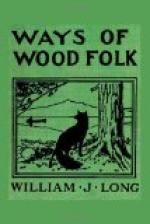[Illustration]
Poor ducky died in my hands a few moments later, the marks of sharp claws telling me plainly that the thief was an owl, though I had no suspicion then that it was the rare winter visitor from the north. I supposed, of course, that it was only a great-horned-owl, and so laid plans to get him.
Next night I was at the same spot with a good duck call, and some wooden decoys, over which the skins of wild ducks had been carefully stretched. An hour after dark he came again, attracted, no doubt, by the continued quacking. I had another swift glimpse of what seemed only a shadow; saw it poise and shoot downward before I could find it with my gun sight, striking the decoys with a great splash and clatter. Before he discovered his mistake or could get started again, I had him. The next moment Don came ashore, proud as a peacock, bringing a great snowy owl with him—a rare prize, worth ten times the trouble we had taken to get it.
Owls are generally very lean and muscular; so much so, in severe winters, that they are often unable to fly straight when the wind blows; and a twenty-knot breeze catches their broad wings and tosses them about helplessly. This one, however, was fat as a plover. When I stuffed him, I found that he had just eaten a big rat and a meadow-lark, hair, bones, feathers and all. It would be interesting to know what he intended to do with the duck. Perhaps, like the crow, he has snug hiding places here and there, where he keeps things against a time of need.
Every severe winter a few of these beautiful owls find their way to the lonely places of the New England coast, driven southward, no doubt, by lack of food in the frozen north. Here in Massachusetts they seem to prefer the southern shores of Cape Cod, and especially the island of Nantucket, where besides the food cast up by the tides, there are larks and blackbirds and robins, which linger more or less all winter. At home in the far north, the owls feed largely upon hares and grouse; here nothing comes amiss, from a stray cat, roving too far from the house, to stray mussels on the beach that have escaped the sharp eyes of sea-gulls.
Some of his hunting ways are most curious. One winter day, in prowling along the beach, I approached the spot where a day or two before I had been shooting whistlers (golden-eye ducks) over decoys. The blind had been made by digging a hole in the sand. In the bottom was an armful of dry seaweed, to keep one’s toes warm, and just behind the stand was the stump of a ship’s mainmast, the relic of some old storm and shipwreck, cast up by the tide.
A commotion of some kind was going on in the blind as I drew near. Sand and bunches of seaweed were hurled up at intervals to be swept aside by the wind. Instantly I dropped out of sight into the dead beach grass to watch and listen. Soon a white head and neck bristled up from behind the old mast, every feather standing straight out ferociously. The head was perfectly silent a moment, listening; then it twisted completely round twice so as to look in every direction. A moment later it had disappeared, and the seaweed was flying again.




